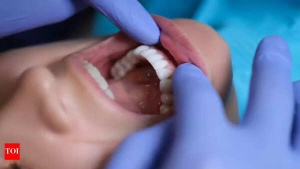Appendicitis is a potentially serious condition that occurs when the appendix becomes inflamed and infected. While the small organ tucked in the lower right abdomen often goes unnoticed, problems can escalate quickly if left untreated, sometimes resulting in a burst appendix, a medical emergency. Recognising the warning signs early is crucial for timely treatment and to prevent severe complications. While sharp abdominal pain is the most common indicator, appendicitis can also cause fever, bloating, nausea, changes in bowel habits, and fatigue. Being aware of these symptoms can help you seek prompt medical care and protect your health.
How to spot appendicitis early: 10 key symptoms
Sudden pain in the lower abdomen
According to a study published in the American Family Physician, the most classic symptom of appendicitis is a sudden and severe pain in the lower right side of the abdomen. This pain occurs because the inflamed appendix irritates the lining of the abdominal wall. Patients may describe the pain differently—some report a sharp, stabbing sensation, while others feel a dull, persistent ache. Typically, this is one of the first warning signs that something is wrong. The pain often intensifies over time and may worsen with movement, coughing, or pressure on the area. Early recognition of this symptom is crucial for prompt treatment.
Bloating
Abdominal bloating is another symptom that may appear with appendicitis. It usually occurs together with abdominal pain, reflecting inflammation and digestive disruption. While bloating alone does not indicate appendicitis, when it appears alongside pain in the lower right abdomen, it is a warning sign worth noting. Paying attention to how these symptoms interact can help determine whether urgent medical evaluation is needed.
Loss of appetite
A sudden loss of appetite is common in appendicitis. The inflammation and digestive upset associated with the condition can make eating uncomfortable or unappealing. On its own, a reduced appetite may not indicate a serious problem, but when it coincides with abdominal pain, nausea, or other digestive symptoms, it can signal appendicitis.
Low-grade fever that increases
A low-grade fever often accompanies appendicitis. Initial fevers may range from around 99°F to 100.5°F. If the appendix bursts, the fever can rise significantly, sometimes accompanied by a rapid heartbeat. This combination of fever and pain indicates a potentially serious infection and requires immediate medical attention. Monitoring temperature changes alongside other symptoms can provide important clues about the severity of the condition.
Nausea and vomiting
Nausea and vomiting may develop with appendicitis, though they are not always present in every case. Interestingly, these symptoms often occur shortly before the abdominal pain begins. While nausea and vomiting can result from many digestive issues, when paired with other signs like lower right abdominal pain and fever, they may indicate an inflamed appendix. Seeking medical attention is important to rule out other causes and prevent complications.
Navel pain
Sometimes, appendicitis pain initially appears near the navel rather than the lower right abdomen. This pain often migrates downward as the condition progresses. The discomfort may feel sharp or dull, depending on the patient. Tracking the movement and intensity of pain can help healthcare professionals identify the problem more accurately.
Changes in bowel movements
Appendicitis can cause constipation or diarrhea, though the pattern varies among patients. In some cases, partial obstruction from an inflamed appendix leads to constipation, while others experience diarrhea alongside nausea. Any sudden, unexplained changes in bowel habits, particularly with abdominal pain, should prompt medical evaluation to rule out appendicitis or other gastrointestinal conditions.
Flatulence
Excessive gas or flatulence is typically harmless, but when combined with abdominal pain and other appendicitis symptoms, it can indicate a more serious digestive issue. Severe abdominal discomfort with bloating and changes in bowel habits should never be ignored.
Fatigue
Fatigue can accompany appendicitis, particularly in cases of chronic appendicitis, where symptoms are less severe but persistent over time. Although not as common in acute appendicitis, persistent tiredness along with digestive or abdominal symptoms may indicate an ongoing inflammatory process in the appendix.
Painful Urination
Painful or frequent urination is a less common but possible symptom of appendicitis. The inflamed appendix can irritate the urinary tract, causing discomfort during urination. While this symptom alone may point to a urinary tract issue, its presence alongside abdominal pain and fever should raise suspicion for appendicitis.
Appendicitis can present with a variety of symptoms, from sudden lower right abdominal pain and fever to digestive disturbances, nausea, and fatigue. Early recognition of these warning signs is vital to prevent complications like a ruptured appendix, which can lead to life-threatening infections. If you experience severe or persistent abdominal pain, fever, nausea, or changes in bowel habits, seek medical attention immediately. Prompt evaluation and treatment by a healthcare professional can save lives and ensure a full recovery.
Disclaimer: This article is for general informational purposes only and is not a substitute for professional medical advice, diagnosis, or treatment. Always seek the guidance of a qualified healthcare provider regarding any medical condition or lifestyle change.
Also Read: 5 symptoms that show your toothache needs an urgent dentist visit

 Wimbledon 2025: Streaming Guide for India & US Viewers - Dates, Prize Money & New Tech
Wimbledon 2025: Streaming Guide for India & US Viewers - Dates, Prize Money & New Tech
 Greg Chappell: Rishabh Pant is Redefining Cricket with His Fearless Batting
Greg Chappell: Rishabh Pant is Redefining Cricket with His Fearless Batting
 Vijay Sethupathi Responds to Controversy Surrounding Son Surya's Film Debut 'Phoenix'; Apologizes if Anyone Was Hurt
Vijay Sethupathi Responds to Controversy Surrounding Son Surya's Film Debut 'Phoenix'; Apologizes if Anyone Was Hurt
 Smith Set for Second Test Comeback After Unique Baseball Cage Recovery
Smith Set for Second Test Comeback After Unique Baseball Cage Recovery
 Spotting Prediabetes: Key Warning Signs Your Body May Be Sending
Spotting Prediabetes: Key Warning Signs Your Body May Be Sending
 JPG to PDF: A Graphic Designer's Guide to Conversion on Desktop and Mobile
JPG to PDF: A Graphic Designer's Guide to Conversion on Desktop and Mobile
 Daren Sammy Fined for DRS Criticism After West Indies-Australia Test
Daren Sammy Fined for DRS Criticism After West Indies-Australia Test
 Google Unveils Strategy to Bolster 2024 Indian Elections: Combating Misinformation and Promoting Voter Access
Google Unveils Strategy to Bolster 2024 Indian Elections: Combating Misinformation and Promoting Voter Access
 Tiêu đề:
Oral Cancer: Know the Signs, Risk Factors, and Why Early Detection is Critical
Tiêu đề:
Oral Cancer: Know the Signs, Risk Factors, and Why Early Detection is Critical
 X Cracks Down: Half a Million Indian Accounts Suspended for Policy Breaches
X Cracks Down: Half a Million Indian Accounts Suspended for Policy Breaches